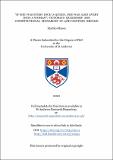Files in this item
"If she was every inch a queen, she was also every inch a woman" : Victoria's queenship and constitutional monarchy in 19th-century Britain
Item metadata
| dc.contributor.advisor | Müller, Frank Lorenz | |
| dc.contributor.author | Okawa, Mariko | |
| dc.coverage.spatial | v, 224 p. | en_US |
| dc.date.accessioned | 2020-11-09T15:53:27Z | |
| dc.date.available | 2020-11-09T15:53:27Z | |
| dc.date.issued | 2020-12-02 | |
| dc.identifier.uri | https://hdl.handle.net/10023/20934 | |
| dc.description.abstract | This thesis explores Queen Victoria’s queenship in nineteenth-century Britain, with a particular emphasis on the impact of her gender on her relationship with the Prime Minister in the context of the development of a constitutional monarchy operating alongside a growth in parliamentary democracy. It will be argued that various sections of society regarded her gender as a positive resource for (re)fashioning the modern form of Britain’s monarchy. Femaleness was presented as facilitating orderly progress. Victoria’s queenship was not only operated by the Queen herself, but also by actors surrounding her showing an active interest in and support for the monarchical institution. Agents such as members of her court, her dynastic relatives and immediate family, Prime Ministers, and a growing and increasingly active public audience (not least the print media) shaped and influenced the style of her rule. This thesis is structured chronologically, ranging from her early years, via the middle period until the last decades of her reign. Each chapter focuses on the premiership of one of three selected Prime Ministers while simultaneously engaging with three overarching themes (the notion of a symbiosis between femaleness of the sovereign and constitutional monarchy; the public feminisation of the monarch; the personal relationship between the Queen and the Prime Minister), thereby illuminating the transformations of the gender dimension of Victoria’s queenship over the course of her reign. By analysing Victoria’s queenship through the lens of her relationship with her male chief ministers, this thesis seeks to shed light on the significance and wider implications of the sovereign’s gender on the evolving functions of Britain’s constitutional monarchy within the nation’s culture, society, political system, and Empire. The thesis contributes to scholarly debates surrounding Britain’s monarchical persistence and popularity in a democratic age and to scholarship on women’s and gender history as well as on modern queenship. | en_US |
| dc.language.iso | en | en_US |
| dc.publisher | University of St Andrews | |
| dc.subject | Constitutional monarchy in 19th-century Britain | en_US |
| dc.subject | Queen Victoria | en_US |
| dc.subject | Modern queenship | en_US |
| dc.subject.lcc | DA555.O6 | |
| dc.subject.lcsh | Victoria, Queen of Great Britain, 1819-1901--Relations with prime ministers | en |
| dc.subject.lcsh | Women heads of state | en |
| dc.subject.lcsh | Great Britain--Politics and government--1837-1901 | en |
| dc.title | "If she was every inch a queen, she was also every inch a woman" : Victoria's queenship and constitutional monarchy in 19th-century Britain | en_US |
| dc.type | Thesis | en_US |
| dc.type.qualificationlevel | Doctoral | en_US |
| dc.type.qualificationname | PhD Doctor of Philosophy | en_US |
| dc.publisher.institution | The University of St Andrews | en_US |
| dc.publisher.department | School of History | en_US |
| dc.identifier.doi | https://doi.org/10.17630/sta/4 |
This item appears in the following Collection(s)
Items in the St Andrews Research Repository are protected by copyright, with all rights reserved, unless otherwise indicated.

